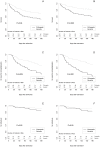Postoperative admission to a dedicated geriatric unit decreases mortality in elderly patients with hip fracture
- PMID: 24454708
- PMCID: PMC3893076
- DOI: 10.1371/journal.pone.0083795
Postoperative admission to a dedicated geriatric unit decreases mortality in elderly patients with hip fracture
Abstract
Background: Elderly patients with hip fracture have a 5 to 8 fold increased risk of death during the months following surgery. We tested the hypothesis that early geriatric management of these patients focused on co-morbidities and rehabilitation improved long term mortality.
Methods and findings: In a cohort study over a 6 year period, we compared patients aged >70 years with hip fracture admitted to orthopedic versus geriatric departments in a time series analysis corresponding to the creation of a dedicated geriatric unit. Co-morbidities were assessed using the Cumulative Illness Rating Scale (CIRS). Each cohort was compared to matched cohorts extracted from a national registry (n = 51,275) to validate the observed results. Main outcome measure was 6-month mortality. We included 131 patients in the orthopedic cohort and 203 in the geriatric cohort. Co-morbidities were more frequent in the geriatric cohort (median CIRS: 8 vs 5, P<0.001). In the geriatric cohort, the proportion of patients who never walked again decreased (6% versus 22%, P<0.001). At 6 months, re-admission (14% versus 29%, P = 0.007) and mortality (15% versus 24%, P = 0.04) were decreased. When co-morbidities were taken into account, the risk ratio of death at 6 months was reduced (0.43, 95%CI 0.25 to 0.73, P = 0.002). Using matched cohorts, the average treatment effects on the treated associated to early geriatric management indicated a reduction in hospital mortality (-63%; 95% CI: -92% to -6%, P = 0.006).
Conclusions: Early admission to a dedicated geriatric unit improved 6-month mortality and morbidity in elderly patients with hip fracture.
Conflict of interest statement
Figures




References
-
- Johnell O, Kanis JA (2006) An estimate of the worldwide prevalence and disability associated with osteoporotic fractures. Osteoporosis Int 17: 1726–33. - PubMed
-
- Johnell O, Kanis JA (2004) An estimate of the worldwide prevalence, mortality and disability associated with hip fracture. Osteoporosis Int 15: 897–902. - PubMed
-
- Rapp K, Becker C, Lamb SE, Icks A, Klenk J (2008) Hip fractures in institutionalized elderly people: incidence rates and excess mortality. J Bone Mineral Res 23: 1825–31. - PubMed
-
- Jiang HX, Majumdar SR, Dick DA, Moreau M, Raso J, et al. (2005) Development and initial validation of a risk score for predicting in-hospital and 1-year mortality in patients with hip fractures. J Bone Mineral Res 20: 494–500. - PubMed
-
- Myers AH, Robinson EG, Van Natta ML, Michelson JD, Collins K, et al. (1991) Hip fractures among the elderly: factors associated with in-hospital mortality. Am J Epidemiol 134: 1128–37. - PubMed
MeSH terms
LinkOut - more resources
Full Text Sources
Other Literature Sources
Medical

